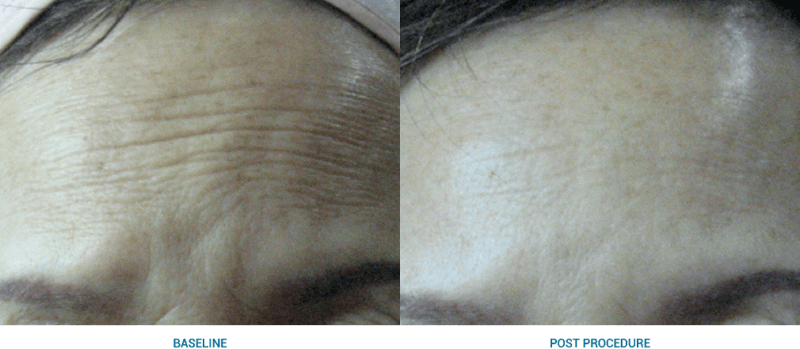Botox
The ageing process is not kind to our skin! A lack of collagen and a decease in elasticity causes lines and wrinkles appear. Some people are just happy to accept this as part of becoming older, but for others…there is Botox!

Botox is a well known and trusted name in the fight against getting older. It involves the injection of the Botox solution to problem areas such as crows feet, foreheads or around the mouth. The treatment works by relaxing the muscle in the chosen area and subsequently creates a smooth more youthful looking complexion.
What areas are suitable for Botox injections?
Forehead and between the brows, crow’s feet, lines at the bridge of the nose, necklines, lines around the lips.
What age should I start having Botox?
Many people think about having Botox treatments around the age of 35. As a general rule, anti wrinkle treatments become an option as dynamic lines ( frown lines, smile lines) are constantly visible. Lifestyle can be a factor. For example if smoke or are often exposed to the sun, you may decide to consider treatment at an earlier age. For patients heading into their 50s, treatment may be less effective as lines have become well established and deeper set.
Is Botox a safe treatment?
Rest assured that your practitioner will have had extensive training and experience in carrying out Botox treatments. Botox is a safe, fast and very affordable solution for those wanting to turn back the clock. For patients who are looking for a more dramatic end result, Botox can be combined with a variety of other treatments including Hifu and Lipofirm Pro.
Side effects from Botox injections are rare although some patients do experience headaches, drooping eyelids, facial pain and muscle weakness. These reactions usually stop within a 72 hour period.
Very rarely, Botox patients have an extreme reaction to Botox which has resulted in pneumonia.
If you are suffering from illness, taking medication, pregnant or breastfeeding you will need discuss this with your doctor prior to treatment. Additionally you should also discuss any previous or planned surgery. inflammation of the muscles or skin, trouble with swallowing and any previous adverse reactions to Botox injections.
How does Botox work?
The nerve endings in the body naturally release a substance called acetylcholine, this causes muscles to contract. The Botox solution contains a substance which is specifically designed to stop the release of acetylcholine. When the muscle is more relaxed the face appears smoother and the appearance of lines is massively reduced.
What other conditions is Botox used for?
Migraines:
For long term sufferers of migraines, Botox is a valued solution. The Botox solution blocks the neurotransmitters which cause a person to experience pain. To ensure maximum effect the treatment should be repeated every twelve weeks.
Excessive Sweating:
Botox injections interrupts the signal between the brain and the sweat glands, eliminating excessive sweating. A patient will need to repeat the treatment every 3-6 months.
Blushing:
Many people experience blushing over the face, neck and chest when in high pressure situations. Botox can help reduce this effect by blocking the signals between the nerve cells that reach the skin and blood vessels.
Gummy Smile
When Botox is injected into the muscle above the lip it prevents it from being lifted as high and reduces the impact of a gummy smile.
Nefertiti Neck Lift
Lines and wrinkles do not only cause problems on the face, the also extend to the neck. Botox is effective for horizontal and vertical lines ensuring it looks more youthful.
What happens during and after the Botox Treatment?
Before your treatment begins a trained professional will outline exactly what to expect. Before treatment begins a numbing cream can be applied to the face although the treatment is relatively pain free. A fine needle will deliver the Botox solution directly into the problem areas.
Depending on which areas are being treated, the sessions can last between 15-45 mins. The treatment is done on a walk in, was out basis with no time required for recovery. To avoid brusing, it is advised that certain medications be stopped prior to the appointment.
Results will be seen in 2-3days. To maintain the appearance the treatment will need to be repeated within 3-6 months time.
Aftercare
To ensure there are no complications following your Botox treatment, you need to adhere to guidelines below.
Following the treatment use a gentle cleanser with tepid water to ensure the face stays clean. Apply serum antioxidants and Hyaluronic acid to reduce irritation and hydrate the skin. Avoid make up for 24 hours where possible and do not use brushes which have not been cleaned.
First 24 Hours
- Do not drink excessive alcohol
- Do not go swimming
- Avoid direct sunlight including sunbeds
- Avoid active skincare which may contain the following ingredients, continue to avoid these substances for a further three days. ( Alpha Hydroxy Acids, Beta Hydroxy Acid, Retinol (Vitamin A), Vitamin c * in low pH formula)
- No excessive or strenuous exercise
- Do not lie face down
- Do not take Ibuprofen for up to two weeks after treatment.
